This story first appeared in the March 2019 edition of Australian Aviation.
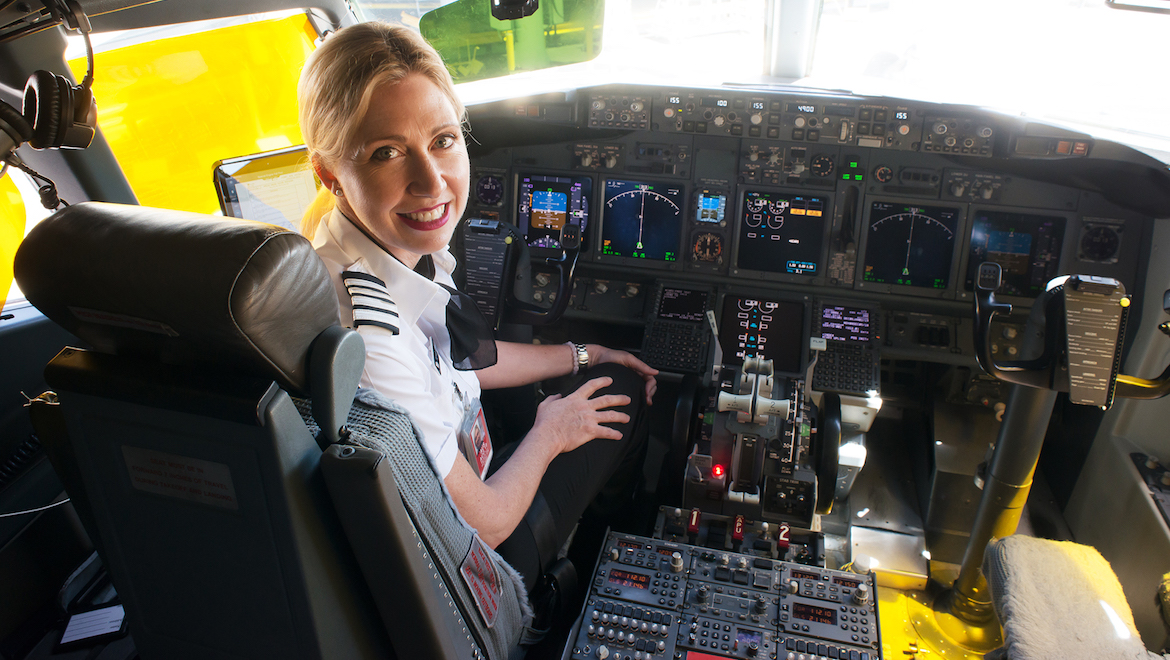
Self-confessed “RAAF brat” Michelle Huntington’s first true taste of flight involved being strapped into the cockpit of a Mirage trainer at the age of seven before hurtling around the sky in some nausea-inducing aerobatics.
Did it put her off flying? Far from it, though today’s “desk” is rather more stable. Michelle is now a Boeing 737-800 Captain with Virgin Australia and her induction to flying at such an early stage is only part of the story. Captain Huntington spoke with Rob Brus in a recent Australian Aviation podcast.
The following is an edited transcript.
AA: Where are you from, and how long have you been a pilot?
Michelle: I’m from Sydney, and I’ve been a pilot for . . . this is coming up to my 20th year.
AA: How many hours have you racked up?
Michelle: Twelve and a half thousand.
AA: All in airliners?
Michelle: Definitely not. It’s been small aircraft, mid-size, small jets, airline, turboprop, and jet aircraft.
AA: You had a pretty interesting introduction to aviation when you were a kid.
Michelle: Yeah, I’m a RAAF brat. So my father was in the air force, and we went overseas. And before the days of OH and S, we were allowed to, as small children, go and play around aircraft on the RAAF base; go and have a look inside the cockpit, go up on flights. So it all became quite normal for me. The great thing was that as a child, of course I had no understanding of the background behind things. I saw it so often that I thought, ‘I could be a pilot easily. These guys seem to command respect, and they don’t do much except flip switches.’ It looks easy.
AA: Do you remember how old you were when that happened?
Michelle: Seven.
AA: Did the RAAFies take you out flying, did they?
Michelle: Yeah, they did all the time. I was able to go up in a Mirage trainer, which would be unheard of now. And then we went up in Hercules, Caribou and Chinooks every week, just in the back, and it was great.
AA: Where were you posted where you could do something like that?
Michelle: Yeah, Butterworth. We lived in Penang.
AA: What do they do? Do they strap a seven-year-old girl into the backseat of a Mirage and take you out for a spin?
Michelle: Yeah, yeah. That was great. Basically try to get me to sick, which I did do.
AA: The loops, roll, some arrows, low level?
Michelle: Rolls and some low level beat up. It was cool. And we went vertical. It was unreal.
AA: That’s a fast jet, too, back in the day?
Michelle: It was. But I never thought of being an air force pilot. It was more the fact that . . . I suppose I liked more the transport aircraft. So while it’s fun to see arrows work, I didn’t have the stomach for it.
AA: So is that where it started for you wanting to fly bigger aircraft?
Michelle: And also, because we were based overseas, we went on a lot of airline flights to and from Australia and other places. And it was always the glamour of it. We had to dress up when we were kids, and it was a special occasion. You looked
at the flight crew and the cabin crew, and they were all so glamorous, and respected.
AA: When was it that you realised that you could be a pilot? Were you at the end of high school?
Michelle: I went to a girls’ school where it wasn’t really promoted (as a career). It was the end of the ’80s, early ’90s, so I was encouraged to pursue other career options. The school I went to was very big on becoming a lawyer or a doctor and a lot of my friends did do that. Instead, I went to uni and did art and had loads of fun, and then did a master’s in archeology. Only at the end of the ’90s did I befriend some people out in New South Wales, part of British Aerospace Flight Training Academy going out of Tamworth. There were a couple of females going through flight training, and I thought, “it’s now or never.”
AA: How old were you when you did that?
Michelle: I was 28.
AA: Aviation is one of those careers that you stick with for a long time, and the earlier (you get into it) the better. Did your age limit you at all?
Michelle: Not at all. It was probably a blessing because I had a bit of maturity on my side. Also, because I was late to aviation I made the decision to do it in a very short space of time. So I did it within 12 months, the whole lot . . . all the way to ATPL and an instructor rating. So I did it six days a week and just stuck to it. So I had focus.
AA: Did you bite off more than you could chew?
Michelle: It was OK. I was lucky in the fact that my previous careers had given me enough finances that I could just go at it full-time. So I had that luxury. And the first flight, I threw up.
AA: Oh, really? You were airsick on the first flight? The Mirage pilot sick on her first flight?
Michelle: I know. My instructor had a go at me. And basically, he had a joke on me and I fell for it.
AA: Do you fly outside of doing airline stuff?
Michelle: I did. A couple of years ago, I flew a friend’s Cirrus, and that was fun. A little scary. (The) flaring is interesting because I’m used to flaring so much higher. But it was just amazing. I went out early. It was a still day, and “this is why I like flying”; so close to the ground. I think we were at six and a half thousand feet or something, and it was beautiful. It was really nice.
AA: You mentioned you had an instructor rating as well. Did you ever actually use your instructor rating?
Michelle: I did. I was at a flying club . . . mainly the general demographic was middle-aged men who had always wanted to be pilots; been very successful in their chosen career and then had the time and money in order to pursue that.
AA: So, we’re doing a story about the day in the life of an airline pilot. What’s a typical day like for you? Are you getting up early? Are you starting in the middle of the day? What does your roster look like?
Michelle: I prefer an early start . . . 5:00AM onwards. In order for me to do that, I would probably get up at 3:00AM. Usually uniform’s ready. I have a shower to wake up and just pull myself into it. And then drive to work. Because now everything’s on iPad, we can breathe. I can have a cup of coffee and have a look at the weather and things before we actually get to work. And then meet up with the crew and start the day.
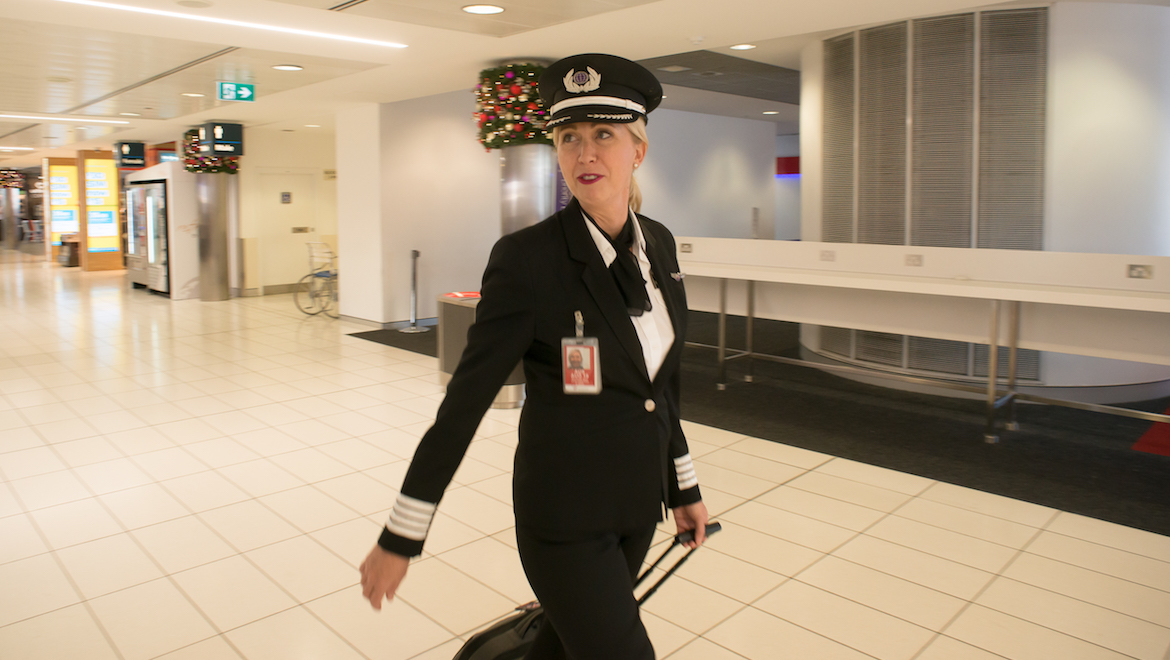
AA: Does it feel like you’re taking small, bite-sized chunks out of what you need to do because you’ve got that?
Michelle: My instructor, my chief pilot, he used to say, “prior preparation prevents piss poor performance.” And it’s true . . . If you can have a look, you’ve got a general idea, you look at the synoptic . . . You know what’s going to happen . . . it makes the day flow easier for you. And because you’ve got a broad understanding of what’s going to happen in the day, if problems arise, you’ve got the brain space to deal with (them).
AA: What’s it like to wake up in the morning and come to work with Virgin? Tell me what the work place is like. What are the people like?
Michelle: It’s pretty jovial. We’re all good mates. And that’s what makes a company, obviously, the people. When you come to work, there are people that you may not have seen for over a year, two years, but it’s like you saw them last week. And you just slip back into what you were talking about. The company as a whole is great. They support us really well.
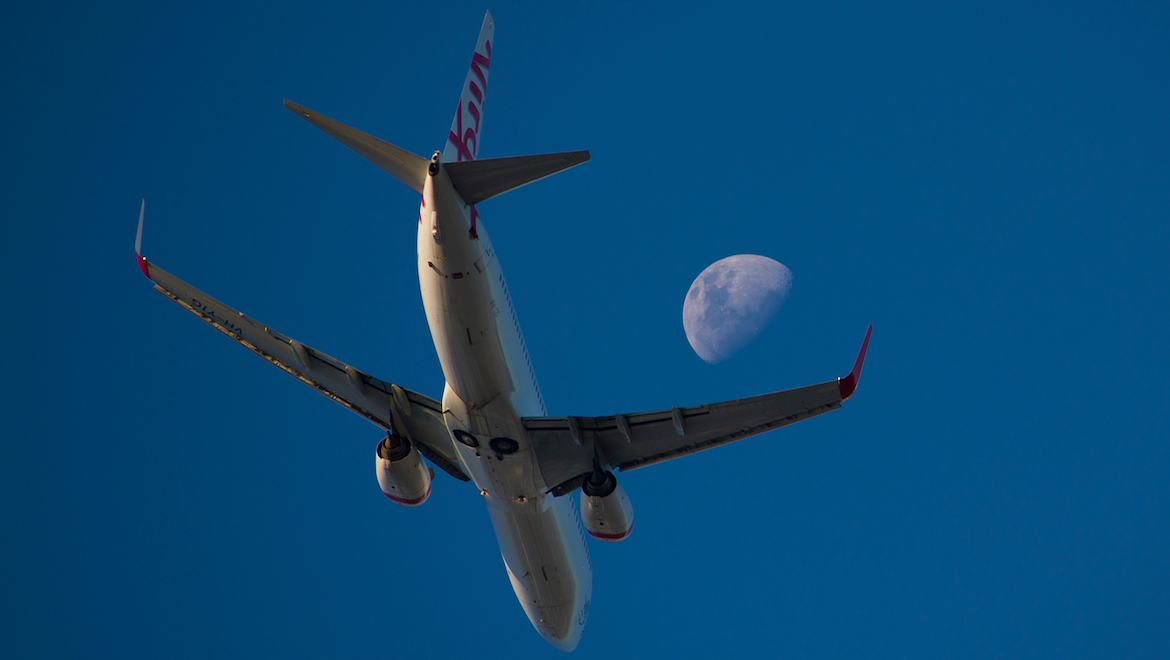
AA: Well, people always look from the outside looking in and always wonder, what’s it like to work there?
Michelle: Look, I’ve got friends who are in all the airlines, and we came from GA together and we worked our way up. And honestly, it doesn’t matter what we’re flying, who we’re flying for. Everyone kind of walks up to an aircraft, and it’s, “yep. we’re pilots” basically.
AA: How long have you been working for Virgin?
Michelle: This is my 11th year.
AA: And was this your first airline job, as well?
Michelle: No. I was with Regional Express before.
AA: Okay. And you were flying around in Saab 340s?
Michelle: I was. Yes.
AA: What’s that like?
Michelle: That’s was fun, too. Again, different aircraft. It was the first turboprop that I’d flown, and a really fun company to work for.
AA: That’s a hands-on machine, too, right?
Michelle: It is, but it’s . . . a good machine. Very, very adaptable. You can go fast until right to the end, basically. So you’ve
got those big fans to stop you.
AA: Coming into the circuit, you mean?
Michelle: Yeah. Even coming into Sydney. We used to go flat out until right when you needed to land. And air traffic control, they appreciate that with Rex that they can manipulate. So it’s not so standard . . .
AA: And what was it like coming out of that airplane and coming into the 737?
Michelle: The transition wasn’t that great. It was good. And we got a lot of support with doing our endorsement here at Virgin.
AA: Was it exciting?
Michelle: Very. I still look out the window sometimes and think, “is it magic that keeps us up?” Honestly. Seventy tonnes of aircraft just barrelling through the air.
AA: So your day kicks off around 3:00 AM. You come into a ready room. You do a pre-flight briefing. You check the weather. Do you know who you’re working with on the day? Is that in a roster?
Michelle: Yes. We have a briefing report. And that can change depending on what’s happened in the day. It’s fairly fluid. But generally we know who we’re working with. And so we’ll meet them either at the aircraft, at the briefing room, or the coffee shop. Basically, we go through the problems together . . . whether (there is) anything wrong with the airport – it could be military operations happening; anything wrong with the aircraft? And then we come up with a plan together because two heads are better than one.
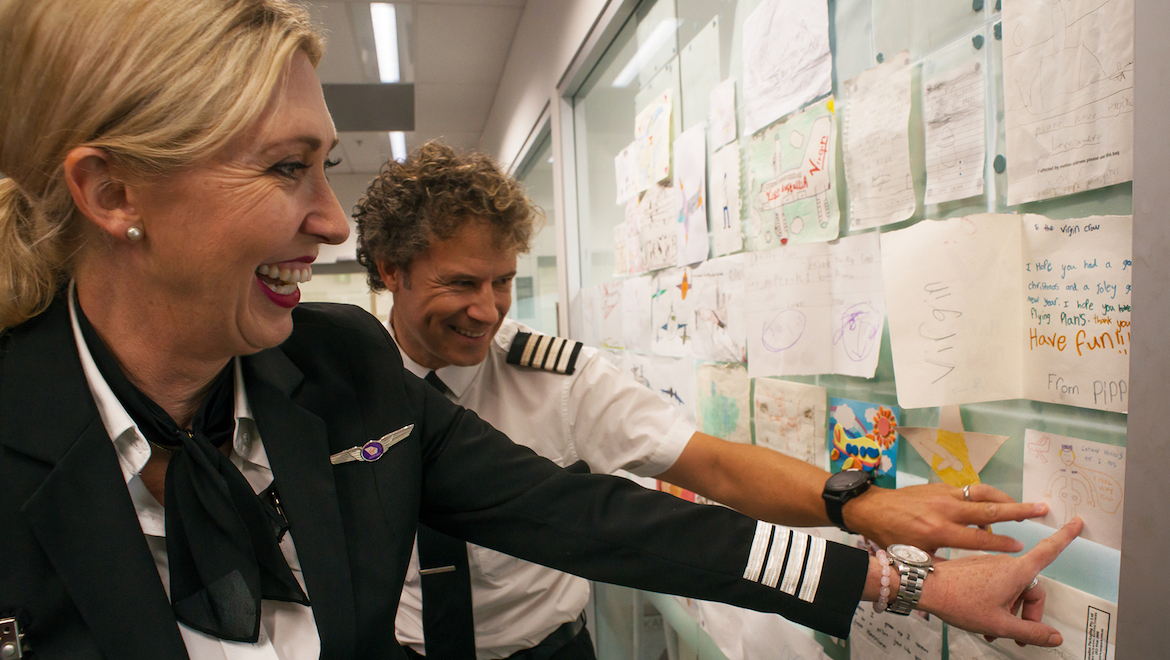
AA: How long does that briefing take with you and the FO?
Michelle: Generally . . . we have to turn up about an hour prior to the flight departing, and we need to be at the aircraft gate by 40 minutes prior to departure.
AA: That’s just at a cup of coffee before you go, looking at your iPad, looking at the weather, discussing what you need to do.
Michelle: That’s right. The fuel required, anything we need to watch out for, any changes in procedures required, and that’s it.
AA: Is it pretty standard? Or is it different every day?
Michelle: Different every day. It is standard in the fact that we know what we’ve got to do. But you could fly the same route five days in a row and it’s always different.
AA: You ever get a curly one coming at you with weather or something completely different left of field? Tell me something that’s “left of field” that happens.
Michelle: Yeah, sometimes. If we go to some of the airports that have shorter runways we’re restricted in weight. But then if the weather’s bad, you need the fuel.
AA: You need the fuel to go somewhere else.
Michelle: That’s right. Or to have a couple of (go-arounds). And so that can be creative thinking sometimes: how to make that all legal and work with the best outcome.
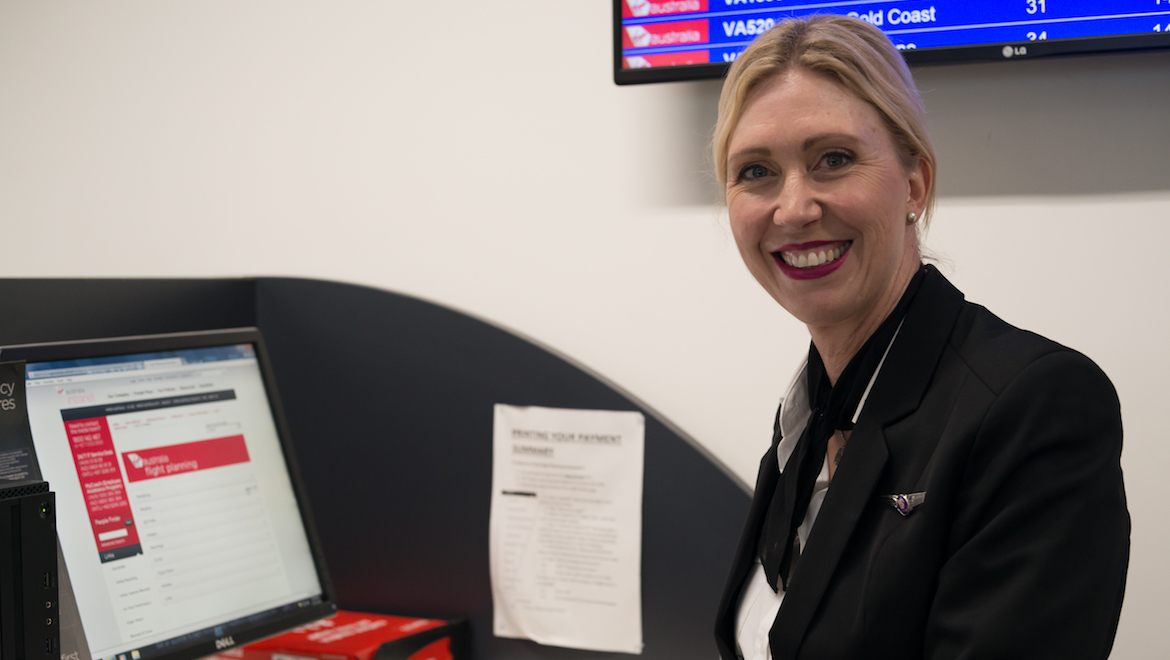
AA: This time of the year, with all the cyclones and the weather up north, how does that impact on alternates and extra fuel and things like that?
Michelle: The company . . . we’ve got a really good fuel policy. Some days, it’s a lot of fuel, and some days we can just go with standard flight plan fuel. But definitely around the cyclones . . . We’ve all been flying, most of us, for at least 10 years.
And you get a feel. You can tell when you’re outside. It feels like summer. You can see the clouds as opposed to the ones that are building up. And so you know, come the afternoon, there are going to be storms.
AA: So you finish your brief, you walk up to the gate, down the narrow bridge, you get into the airplane. What’s the first thing that you do? Is there a maintenance release?
Michelle: There is. So we have a maintenance log. It’s similar to a maintenance release, and we just make sure that it’s in within hours and that all the covers and straps have been removed. At this time of year, lightning strikes are quite an issue and our company goes through them with a fine-toothed comb.
AA: Can you get struck by lightning and not know?
Michelle: Oh you can. Yes. Definitely. And static discharge.
AA: And what happens when you get struck by lightning and you do know? What do you see on the flight deck?
Michelle: Well, you hear it quite often. The bang.
AA: What’s it sound like?
Michelle: Huge bang.
AA: Just like a bang?
Michelle: Yeah. Yeah. And if we don’t hear it, the cabin does, and they tell us.
AA: Somebody tells you.
Michelle: Straight away. I’ve never had anything else go wrong in the flightdeck as far as with being hit by lightning. We do have checks that we do after we have been.
AA: So you get into the flightdeck, put your bag down, and it’s time for a walk-around. Who does the walk-around? How do you decide who’s flying the first sector and who’s going first?
Michelle: So usually the Captain does the first walk-around, and then, if it’s raining, the First Officer. As far as who flies first, depending on the experience of the other pilot, or if it’s a night take-off and I haven’t done night for a while, just to keep recency, I’ll suggest that I do that one. Otherwise, it’s pretty well an open sort of flightdeck where we say, “do you want to have a go?” If we are doing a different approach (we usually go ILS to ILS, not GLS to GLS); if it’s a circuit the first officer hasn’t flown a circuit for a while, I give them the opportunity.
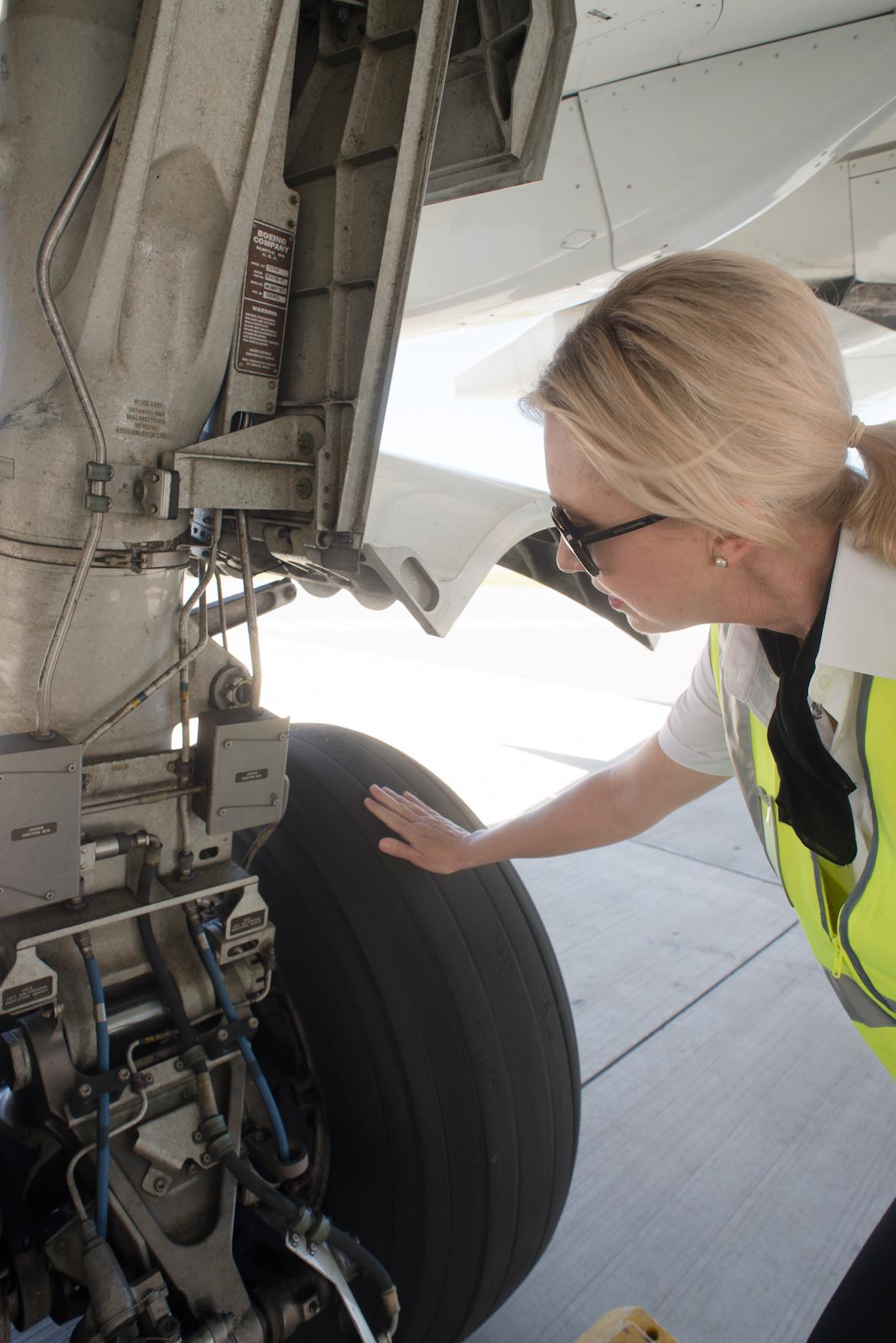
AA: So the walk-around is complete. You come back into the airplane, settle in, finalise the paperwork. Is that the last thing before we go?
Michelle: That’s the last thing before we go, and I’ve briefed the cabin crew usually, the cabin supervisor, just letting them know flight time, what the conditions are going to be like in flight – they need to plan whether they’re going to do hot drinks or not; get the carts out.
AA: So you’re all settled into the flightdeck, paperwork’s good, briefs are good. Ready for a push-back?
Michelle: Yes.
AA: Doors are closed, passengers are good to go, and then off we go on to the first sector. So we get there at the other end, arrive at the gate, and this is one of how many sectors, as a rule of thumb, you fly? Two, three, four?
Michelle: Yeah. Two, three, four.
AA: How many is it?
Michelle: Well, any of those. It can be just a simple two-sector day or even one-sector day to go somewhere on a trip. And then it can be up to four sectors.
AA: And you’re doing domestic and international or just domestic?
Michelle: I do domestic with some flying in and out of New Zealand and Nadi.
AA: Where’s your favorite place to go?
Michelle: Darwin’s interesting. It’s such a wide runway. We usually land on 30m up to 45m (wide) strips, and it’s a 60m strip. So the whole perspective is just weird because you think you’re really close, and you’re not.
AA: (Are) there some really dangerous places that you go to frequently, with weather and things like that. You mentioned Hamilton Island. Why is that? Because it’s so short and narrow?
Michelle: It’s short and narrow.
AA: Did you ever fly out to Lord Howe Island in GA?
Michelle: Yeah.
AA: Right. In a Saab?
Michelle: No, no. I used to fly . . . I’ve flown Cherokees, Cessnas, Chieftans, 401s.
AA: So a lot of turbulence at the end of the runway there, right? Because of the mountain and the hill?
Michelle: Both ends, the wind can be from different directions.
AA: And there’s nowhere else to go in a single.
Michelle: Correct.
AA: Did you ever have to go around there?
Michelle: I have gone around. Yeah. I was in a Cherokee 140, and I went around and then came back.
AA: And you got up the next one around?
Michelle: Yes.
AA: What about the 737? Do you go around much?
Michelle: No, I haven’t. But it’s just more luck than anything else. Because there are days when that’s the safest option.
AA: Does it happen often?
Michelle: Not too often, no. But if it’s . . . well, wasn’t there a flight with Prince Harry on board that went around into Sydney Airport?
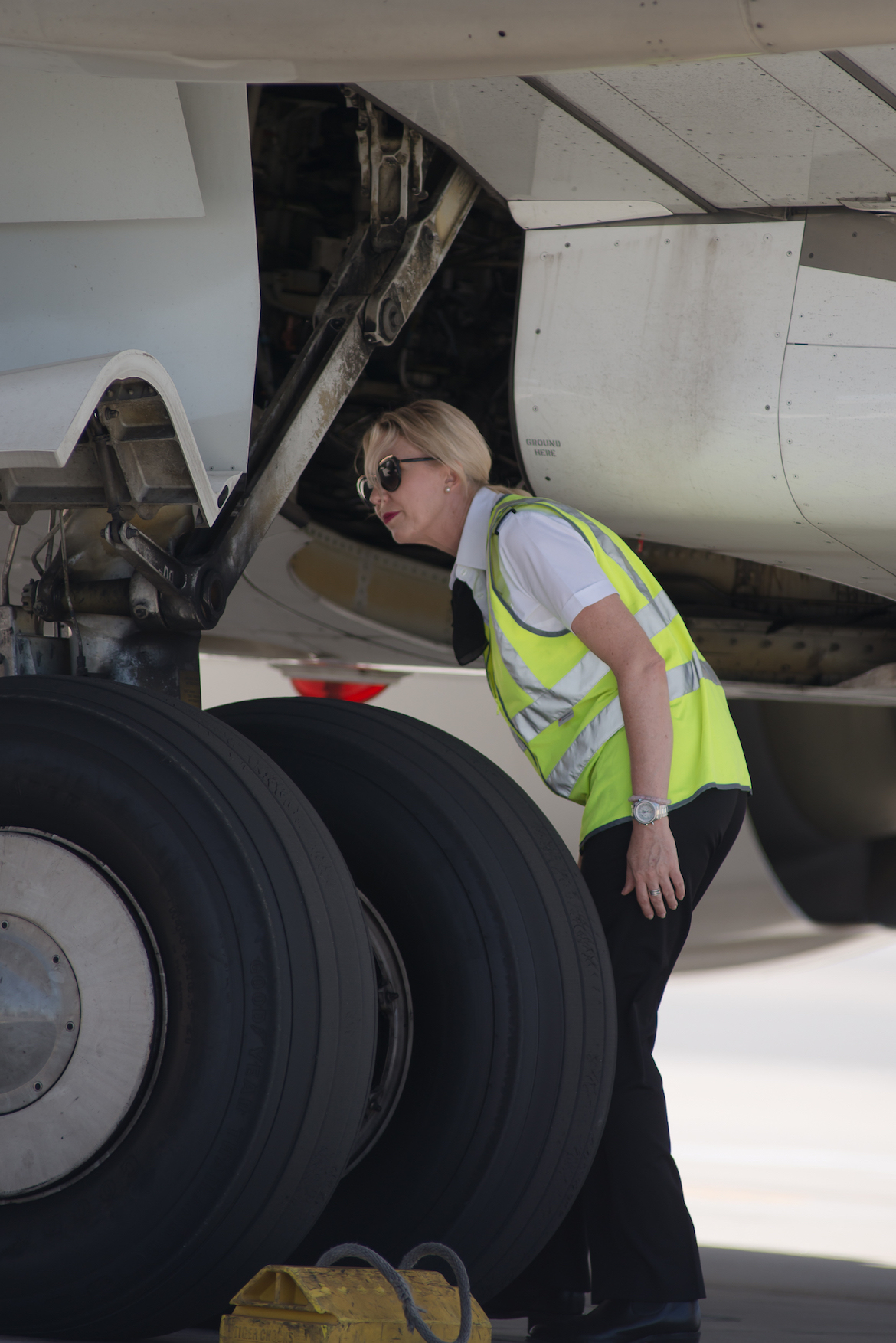
AA: Does the Sydney curfew impact you as an airline pilot?
Michelle: Yes, it can. If there are delays at the beginning of the day, they definitely impact (the) onward roll. But the crew that generally handle that – as in the ground crew wherever you are, Melbourne or Brisbane – they are so with it that they’ve got it down to a fine art.
AA: So what happens? How do you know which clock is right? Is it your watch? Is it the clock in the airplane? Is it the GPS? What are you going off?
Michelle: Well, the clock on the aircraft’s from the GPS, so . . .
AA: So that’s the one you’re using?
Michelle: Yeah.
AA: And it’s 10:22:59 and you’re almost on the ground, are you still going?
Michelle: Yes, yes. You’re still going until you get told not to.
AA: And who tells you not to?
Michelle: Air traffic control.
AA: What are they saying? That’s it? That’s the curfew?
Michelle: Go around.
AA: Go around. Which means, “Get lost.”
Michelle: That’s right. Missed approach.
AA: So where do you normally go? Is that briefed . . . So if you’ve gone to Melbourne or you’ve come from Melbourne, do you go back to Melbourne? Or is it somewhere else?
Michelle: Depends on the company operations. So they will have a plan in place. So, generally, we go back to where we’ve come from because the passengers have come from there.
AA: If you did have to go around and you missed the curfew in Sydney and ended up back in Melbourne, they’d put you up in a hotel?
Michelle: Yes.
AA: Do you ever get tired of living out of a suitcase?
Michelle: It can become a little bit of a bore after a while, and it’s definitely not so glamorous. Maybe for others. Not for me.
AA: Do you have a little routine? Do you have a physical routine? Do some exercise? Some meditation. Some stuff like that.
Michelle: Music’s my thing, so I take music everywhere. But I do. I always go for a walk. Try and get out of the hotel. Take my active wear wherever I go, and then go and grab a coffee or something.
AA: How long does an airline pilot do an overnighter? Is it just a domestic pilot? Just one night?
Michelle: Yeah. The minimum time is 12 hours we get on an overnight. Some trips, we have 56 hours off. And in those circumstances we generally get family and friends to come with us or meet us there, or we catch up with friends. We’ve got friends in every port.
AA: Virgin sounds very social.
Michelle: It is. It is. It’s a great place to work. Yes.
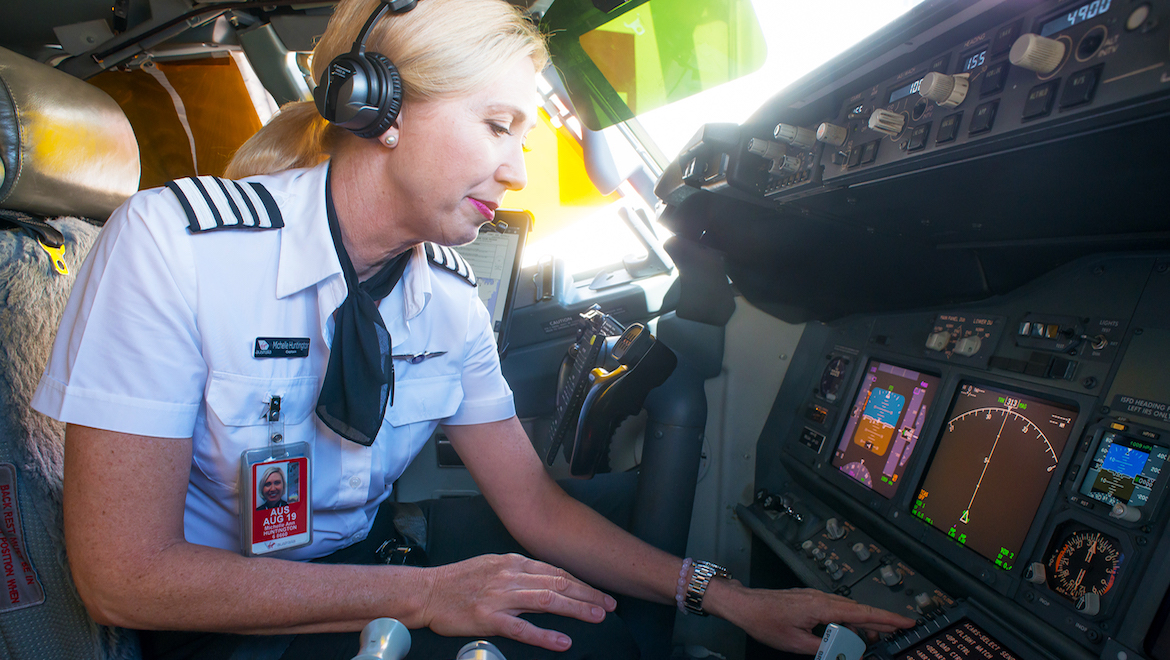
AA: Tell us about being an actual airline pilot; for the women out there considering this, or for the parents out there with young daughters . . . What would you say to some young kids in high school about being a pilot as a career choice?
Michelle: It’s great. And the fact that it is versatile . . . it’s like shift work to a degree, but the days change. You get to meet so many people. And also it’s good that you can still be social; yet can exercise the left-hand side of your brain. The significance is that you are a valued member of the team. And, also, men and women contribute in different ways based on their upbringing, their experience . . . their culture. And so it’s a great mix. It really is.
AA: That’s the one thing that struck me . . . it was like one big team, and everybody was really good mates. So what’s next for you, Michelle? You’ve made it all the way to Captain at Virgin? Do you get a go in a 777 across the pond to the United States? Is that something that interests you?
Michelle: Maybe down the track. I’ve got young children, and so this at the moment is a perfect work life and situation.
AA: How old are the kids?
Michelle: My youngest are eight. So I’ve got two eight-year-olds and an older boy. But yeah. So maybe in a few years when they’re sick of me, I might look at going onto the 777. But it’s a highly sought after job, that one.
AA: Is it? Right. Why so?
Michelle: Because it’s a 777 aircraft, which would be great to fly, longer sectors, just the opportunity to be overseas. So different destinations, more money.
AA: Yeah, you’re paid a little bit more, right?
Michelle: That’s right. Yeah.
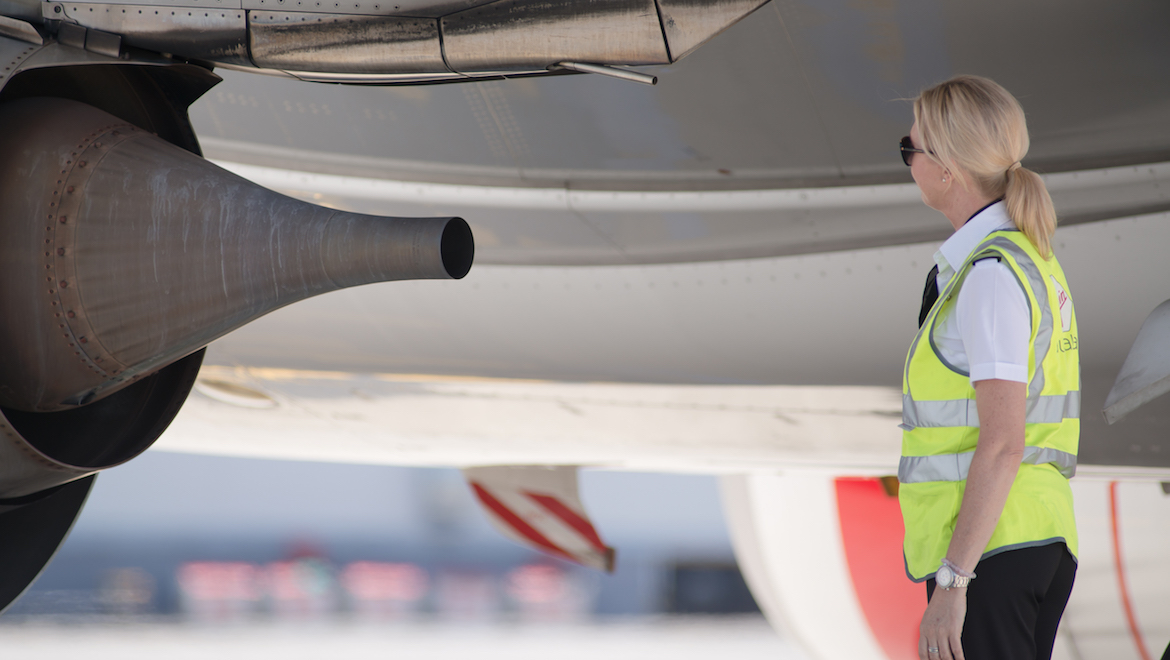
The full podcast is available on the Australian Aviation website.
This story first appeared in the March 2019 edition of Australian Aviation. To read more stories like this, become a member here.










